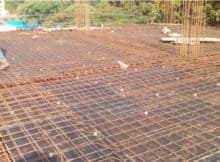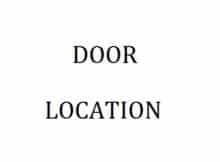Curb and gutter are two different terms in construction. Many of us often get confused with them. In this article, we will discuss different types of curb and gutter, and their advantages and disadvantages.
What Is Curb?
A curb is generally a small wall-like structure constructed and installed along the periphery of the road. A curb is provided to strengthen the pavement of the road.

A curb serves as a partition between the road and the yard and separates both of them. It is provided in light pavements as well as heavy pavements.
What Is Gutter?
A gutter is provided adjacent to the curb. It is also constructed using concrete or asphalt. The main purpose of providing a gutter with a curb is to drain out the rainwater from the pavement of the road.
Usually, a curb and a gutter are constructed together at the same time on a road and are constructed adjacent to each other. There are different types of curbs and gutter discussed further.
Types Of Curbs
There are 5 different types of curbs and gutters. They are as follows:
- Mountable curb and gutter
- Mower curb and gutter
- Barrier curb and gutter
- Monolithic curb and gutter, and
- Slanted curb and gutter
1. Mountable Curbs
A curb having a slight dip on one of its faces is known as a mountable curb. A dip is provided on the face of the curb to facilitate the movement of vehicles over it from the road.
This type of curb usually provides an opening for pedestrians with shopping carts or strollers and those who are on bicycles or skates to safely cross the sidewalks.

2. Mower Curbs
Mower curbs are preferred in the locations where there are lawns and flowering areas. Mower curbs are decorative and provide good aesthetics to the location where they are installed.
Besides the aesthetics, they are strong and protective too. A mower curb acts as a barrier between the lawns or the flowering area and the road.
The unique shape of the mower curb is designed in such a way that each blade of grass is trimmed evenly using the lawnmower without damaging the equipment.

3. Barrier Curb and Gutter
Barrier curbs are the most ordinary types of curbs among all of them. It is the most common and used widely.
It usually acts as a barrier, and it is provided to separate the vehicles running on the road from the sidewalks or footpaths and parking lots.
The barrier curbs are constructed out of cement, concrete, and asphalt aggregates.

4. Monolithic Curbs
Also known as an integral curb, the monolithic curb is constructed in such a way that it connects to the road.
The top part of the monolithic curb is constructed in such a way that it makes it easier for vehicles to pass without damaging the curb structure and its foundation as well.
The foundation of the monolithic curb is constructed using concrete or asphalt. A monolithic curb creates a relatively smooth transition into the road as compared to other types of curbs and gutters.

5. Slanted Curb and Gutter
Slanted curbs are also known as sloped curbs. They are purely constructed for ornamental and aesthetic purposes. There is no practical use as such.
Slanted curbs are only meant to decorate the exterior parts of residential and commercial buildings and are used to showcase the creativity and sense of style of property owners, landscape designers, and contractors.

Construction Procedure Of Curb And Gutter
The sequence of the procedure for the construction of curbs and gutters is as follows:
1. Measurements and Markings
The first and foremost step of the construction of the curb and gutter is to mark out the markings on the pavement as per the measurements given in the plan.
It is important to mark the exact parts of the road or the properties where the curb and gutter will be installed.
Marking will ensure the accuracy of measurement of curb and gutter as per the plan and drawings.
2. Excavation Of Soil
The next step in the construction procedure of the curb and gutter is to excavate the soil. This is done once the marking is completed.
Soil excavation is carried out to construct the foundation of the curb and gutter. Usually, the soil is excavated up to a depth of 300 mm, and the soil obtained is stored for use.
3. Formwork
A formwork, usually made out of wood or metal, is placed and hammered in the ground. It is placed in such a way that the concrete takes the required shape of curb and gutter structure, as mentioned in the drawings.
4. Concreting
Once the formwork is placed firmly, the concrete is poured into the formwork so that the concrete takes the desired shape of curb and gutter.
5. Curing
The concrete is allowed to dry for some time and when it is completely dry and matured, the formwork is deshuttered and the structure is cured for several days. Curing is done so that the concrete gains enough strength.
Advantages Of Curb And Gutter System
1. Curb provides aesthetic beauty to the location where it is installed.
2. Curbs and gutters separate the road from parking and gardens, making it a
dedicated area for walking or parking.
3. It supports and holds the pavement of the road.
4. The curbs are provided with a reflective layer on them. The reflective layer helps to improve visibility at night, minimizing the risk of accidents.
Disadvantages
1. The construction of curbs and gutters requires skilled workers.
2. If they are not maintained, they may get choked up, resulting in
accumulation of water on the road.
Also Read
Types Of Roads – Detail Classification
Road Marking – Types & Purpose
Monolithic Slab Vs. Floating Slab
Different Types Of Patterns In Road
Cement Concrete Road Advantages
Follow our Facebook Page, Linkedin Page & Telegram Channel.





really you are very helpful for us in civil engineering . I like your every post because every post is helpfull
You really are helpful, Thank you so much!
I wondered about your post and wanted to say that I have really enjoyed reading your blog post on Curb and Gutter. Very informative, I hope you post again soon.